Science Highlights, June 2019
Awards and Recognition
Educational Outreach
Team completes 45th Advanced Homemade Explosives Course, achieves Program of Record
Claire Sanders and Scott Cram lecture at the 41st Annual Course in Cytometry
Ricardo Lebensohn teaches Texas A&M’s Summer School on Computational Materials Science
Materials Science and Technology
Fusion-relevant simulations show new helium bubble growth mode in tungsten
Awards and Recognition
Even, Zhu, Yang, and Batista win Postdoc Distinguished Mentor Awards
Wesley Even, Jian-Xin Zhu, Ping Yang, and Enrique Batista are winners of the Laboratory's 2018 Postdoc Distinguished Mentor Awards. The Postdoc Distinguished Mentor Awards recognize the positive impact and contributions that a mentor makes during a postdoc’s appointment and who demonstrated a level of mentoring substantially beyond expectations.
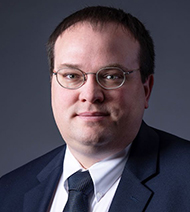
Wesley Even
Wesley Even, CCS-2
Wesley Even (Computational Physics and Methods, CCS-2) was nominated for his dedication to postdocs, his scientific integrity, and his commitment to the Laboratory’s mission. During his 10 years at the Lab, Even has made substantial contributions to the field of theoretical astrophysics. He considers both the recruitment of excellent postdocs and furthering their careers in scientific success as top priorities.
Even has displayed exceptional intuition for valuable research projects, often cross-disciplinary, and connecting his postdocs with collaborative researchers to develop the projects to fruition.
His excellent track record for conversions of postdocs into staff members is not only important for the Lab workforce but demonstrates his ability to create a fulfilling research environment with rich career-furthering opportunities. All of his mentees are thrilled to see him receive this award recognizing his positive and lasting impact on their lives and careers. Technical contact: Oleg Korobkin
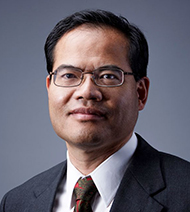
Jian-Xin Zhu
Jian-Xin Zhu, T-4
Jian-Xin Zhu (Physics of Condensed Matter & Complex Systems, T-4) was nominated for his dedicated mentorship of young scientists. Zhu is committed to scientific excellence and fostering an environment of intellectual collaboration among his postdocs and peers. His holistic, long-term approach to mentorship has helped ten former postdocs start prestigious careers in both academia and industry.
Zhu is unfailingly generous with his time and insights as well as introductions to his extensive network of colleagues that includes both theorists and experimentalists. All of Zhu’s mentees, former and present, are delighted to see him rewarded for his hard work and exceptional leadership. Technical contact: Zhoushen Huang
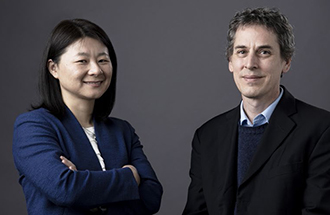
Ping Yang (left) and Enrique Batista
Ping Yang (T-1) and Enrique Batista (T-CNLS)
Ping Yang (Physics and Chemistry of Materials, T-1) and Enrique Batista (Center for Nonlinear Studies, T-CNLS) were nominated as a team for their tremendous efforts in fostering a work environment that supports and encourages both the professional and personal development of their postdocs.
Despite their busy schedules, Yang and Batista make it a priority to be available for discussions with their postdocs and students. They mentor with trust and offer freedom—they provide guidance while not imposing their specific way of working. This effective mentorship, where their postdocs’ professional independence and long-term collaborative projects are supported, translates to high-quality scientific production and career opportunities. Yang and Batista also understand the importance of family and work–life balance, encouraging their postdocs to have a life outside of work as well as organizing group gatherings to foster friendships in a natural and warm environment. Technical contact: Julie Jung
Cincio, El-Atwani, and Maurya win Lab’s Distinguished Postdoctoral Performance Awards
Lukasz Cincio (T-4), Osman El-Atwani (MST-8), and Sandip Maurya (MPA-11) have each won a 2018 Laboratory Distinguished Postdoctoral Performance Award. The Laboratory Distinguished Postdoctoral Performance Awards recognize individuals or teams of no more than three who were major contributors towards outstanding and unique research resulting in a positive, significant impact on the Lab’s programmatic efforts, or status in the scientific community. Technical contact: Mary Anne With
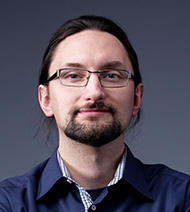
Lukasz Cincio
Lukasz Cincio (T-4)
Lukasz Cincio (Physics of Condensed Matter & Complex Systems, T-4) is recognized for exemplary research on tensor networks and quantum computing. Tensor networks are a powerful computational technique for solving a variety of many-body problems and simulating strongly correlated systems including the characterization of emergent topological order.
Cincio investigated the search of new quantum computing algorithms with machine learning. His work on entanglement spectroscopy provides the best-known algorithm to evaluate entanglement properties of quantum states on near-term quantum computers. Additionally, Cincio made significant progress on the outstanding problem of optimal compiling of quantum circuits. His work has already garnered more than 500 citations. Cincio is also a co-organizer of the first two quantum summer schools for which he has been recognized with a Laboratory Achievement Award. Cincio’s work on quantum computing directly contributes to Los Alamos’ mission in Advanced Strategic Computing, in particular to the Beyond Moore’s Law program. Cincio earned a Ph.D. in Physics from Jagiellonian University. Wojciech Zurek (T-4) and Filip Ronning (MPA-CMMS) mentor him.
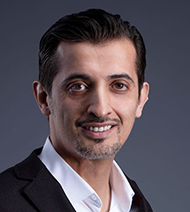
Osman El-Atwani
Osman El-Atwani (MST-8)
Osman El-Atwani (Materials Science in Radiation & Dynamics Extremes, MST-8) is recognized for outstanding research and leadership in fusion materials and plasma fusion technology. His work focuses on the irradiation response and mechanism of nanocrystalline tungsten and tungsten–titanium alloys—materials that show promise for fusion energy applications. Most recently, he investigated the underlying mechanisms of defect formation and the role of grain boundaries on damage evolution via high-resolution electron microscopy on ion-irradiated fine-and course-grained tungsten and tungsten–titanium alloys. This study resulted in a new understanding of how helium and defects interact with grain boundaries, where the defect kinetics are slightly perturb, which may have significant consequences to damage evolution.
El-Atwani is also highly engaged in establishing a new research capability to advance plasma-material interactions at the Ion Beam Materials Laboratory (IBML). This new capability, unique to the Lab, couples a cold plasma gun device with the IBML’s dual-beam chamber, allowing investigation of plasma-surface interactions under fusion-relevant environments for the first time. El-Atwani earned a Ph.D. in Materials Engineering from Purdue University. He was co-mentored by Stuart Maloy and Osman Anderoglu (MST-8).
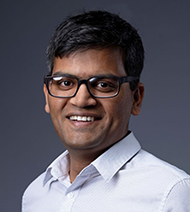
Sandip Maurya
Sandip Maurya (MPA-11)
Sandip Maurya (Materials Synthesis and Integrated Devices, MPA-11) is recognized for outstanding levels of creativity, personal dedication, and technical acumen related to the development of alkaline fuel cell systems. His contributions have helped sustain and grow the Lab’s reputation in the areas of high-temperature polymer fuel cell and redox flow battery R&D.
Maurya’s contributions aided in establishing several key capabilities at the Laboratory, enhancing the Lab’s position as a leader in several technological areas related to energy storage and delivery. His work will significantly impact new fuel cell technologies as well as the usage of redox flow systems, which are capable of storing energy available from renewable sources such as solar or wind for discharge during periods of peak demand. His scientific accomplishments helped the Lab secure new programmatic funding dollars, from both federal and private sources. Maurya earned a Ph.D. in Environmental Science and Engineering from Gwangju Institute of Science and Technology. Yu Seung Kim and Rangachary Mukundan (MPA-11) mentor him.
Chemistry
Neutral uranium(VI) sulfido compound isolated and characterized for the first time
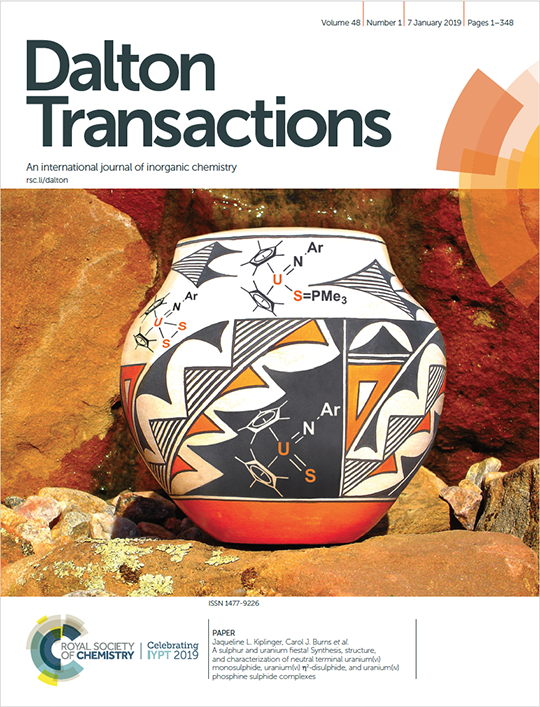
The cover art highlights the new uranium sulfido and other molecules made in this study on a New Mexican Acoma pot, a favorite of Professor Richard A. Andersen (UC-Berkeley). The Ar on the cover refers to “aryl,” which is any functional group or substituent derived from an aromatic ring. Jim Cruz (CPA-CAS) is gratefully acknowledged for help with the publication cover art design.
The topic of uranium-element multiple bonding has long been a subject of interest to actinide scientists. While uranyl (UO22+) is the most common form of uranium in nature, other uranium multiple-bonded species are difficult to synthesize. An important interaction that has been largely elusive for actinide chemists is uranium–sulfur double bonds, known as a uranium sulfido (U=S). These uranium sulfide linkages have particular relevance to actinide–lanthanide separations, where the “softer” sulfur atom allows for the removal of certain heavy elements from others. In molecular chemistry, there are few uranium sulfidos that have been synthesized, however, those that have been are all anionic (being negatively charged limits their utility in helping researchers to understand the uranium–sulfur double bond). This has changed with a recent report by Justin K. Pagano (Seaborg Postdoctoral Fellow, C–IIAC), David S. J. Arney (formerly C division), Brian L. Scott (MPA-11), David E. Morris (C–IIAC), Jaqueline L. Kiplinger (C–IIAC), and Carol J. Burns (DDSTE) who synthesized several new compounds with uranium–sulfur bonds, including a neutral uranium(VI) compound with a terminal uranium sulfido ligand. These groundbreaking compounds offer researchers a unique opportunity to study the properties and advantages of uranium–sulfur bonding interactions.
The uranium–sulfur bond of the terminal sulfido compound was found to be the shortest structurally authenticated, signaling that this was indeed a true uranium–sulfur double bond. UV–visible spectroscopy showed that the interaction between the “soft” sulfur atom and the “hard” uranium atom is expectedly much weaker than that of a uranium imido (U=NR) species which contains a more favorable “hard-hard” match. This suggests that U=S bonds may be very reactive and allows for a better understanding of how this linkage may be found in natural settings. This knowledge will also help researchers harness U=S bonds for separations technology and other chemical applications.
This research was published online in Dalton Transactions in a special issue honoring Richard A. Andersen’s 75th birthday. Richard A. Andersen has long been a pioneer in the field of molecular f-element chemistry, and Dalton Transactions is a leading international journal featuring cutting-edge research in inorganic chemistry.
Reference: “A Sulphur and Uranium Fiesta! Synthesis, Structure, and Characterization of Neutral Terminal Uranium(VI) Monosulphide, Uranium(VI)η2-Disulphide, and Uranium(IV) Phosphine Sulphide Complexes,” Dalton Transactions, 2019, 48, 50–57.
This research supports the Laboratory’s Energy Security mission and the Information Science and Technology and Materials for the Future Science Pillars. The research was supported by Los Alamos National Laboratory Directed Research and Development program (LDRD), the Glenn T. Seaborg Institute for Transactinium Science, and the DOE Office of Science Heavy Element Chemistry Program.
Technical contact: Jaqueline L. Kiplinger
Earth and Environmental Sciences
Predicting earthquakes with machine learning
Predicting when and where the next earthquake will occur is a fundamental goal of geoscience that has long stymied researchers. With thousands of seismic stations around the world collecting data from as early as the 1930s, there is an incredible volume that is potentially useful for prediction. Until recently, the massive size of these datasets has made it nearly impossible to separate signals from noise.
Capitalizing on advances in artificial intelligence, researchers led by the Laboratory’s Earth & Environmental Science division (Geophysics, EES-17) have found a way. Using machine learning (ML) to process data generated during laboratory experiments, they discovered hidden signals that precede “labquakes.” The ML algorithms they developed use acoustic signals emitted by experimental faults to accurately predict the timing, duration, and magnitude of laboratory earthquakes. They can also distinguish between types of failures, from slow-slip—representing non-earthquake tectonic creep—to fast-slip—analogous to high-magnitude earthquakes—events. Following successful prediction in the lab, they applied the same technique to real seismic data from Cascadia and were able to accurately estimate fault displacement rate, allowing real-time monitoring of the fault’s physical state with potential for improved earthquake hazard assessment for the region. This work was recently published in Nature Geosciences.
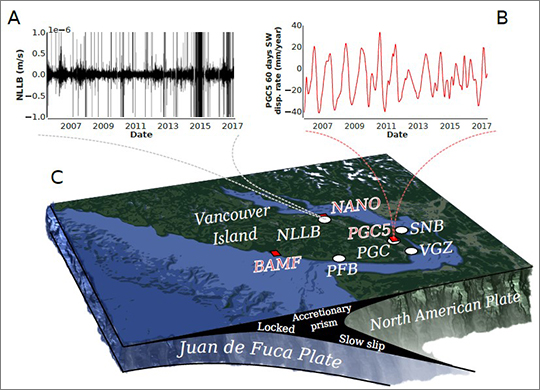
Map and schematic the Cascadia subduction zone. Researchers used ML to identify characteristics of the full continuous seismic data (A) to accurately estimate the GPS displacement rate (B). (C) Seismic stations (white) and GPS stations (red).
Creating a Laboratory Earthquake for Learning
ML exploits computer programs that expand and revise themselves based on new data. Researchers used this approach to derive a fundamental relationship between the sounds emitted by a fault (acoustic, or seismic, data) and its physical state (i.e., shear stress in the lab) or fault displacement rate in Cascadia.
For preliminary testing, they developed a system to replicate earthquakes in the laboratory. Three steel blocks are placed side-by-side and separated by glass beads representing the debris produced when a fault moves. To mimic tectonic forcing, a piston drives the central block relative to the fixed side blocks. By varying the force holding the blocks together (“normal stress”) and the driving velocity (“shear stress”) imposed on the system, researchers were able to produce a range of failure modes representing slow and fast failure events. The shear stress imposed on the system is recorded along with the acoustic emission, or vibration, emanating from the shearing layers. As the gouge material begins to fail, many small shear failures cause an acceleration in acoustic emissions. This instability concludes in a laboratory earthquake, as the center block rapidly displaces causing a sharp decline in friction and shear stress.
Acoustic Data from the Quake is Used to Build a Model
Researchers applied ML to the continuous acoustic data recorded from the fault to see if they could predict the instantaneous stress state of the system. First, the algorithm builds a model relating the shear stress and acoustic data using a training set (60%) of each dataset. The acoustic data is turned into a database of statistical features and fed to an ensemble of decision trees that partitions the data to build a model of shear stress as a function of statistics of the seismic data. The most useful statistical features from each time window of acoustic data are selected recursively and used for further prediction. Once the model is built, its ability to predict shear stress using only the acoustic data is evaluated with the remaining 40% of the data (“testing set”).
Using this ML approach, researchers were able to accurately predict the stress imposed on the laboratory fault from the seismic signal it emitted. The same approach was used to build models relating the seismic signal and time to both beginning and end of fault failure with similar accuracy, allowing for inference of earthquake duration and failure mode (fast vs. slow). The models accurately predict shear stress and time to failure not only when failure is imminent but throughout the entire laboratory earthquake cycle. The ML approach was able to detect signals in the acoustic data occurring long before failure that were previously overlooked as noise.
To explore the underlying mechanics of their models, the authors isolated the single most important statistical feature identified by ML and used it to build a simplified model. In all cases, the signal variance, a metric proportional to the acoustic power, emerged as the best predictor. The simplified model retained its accuracy and allowed prediction of shear stress from acoustic power alone. This exercise revealed distinct patterns in the relationship between shear stress and acoustic power for slow- as compared to fast-slip events. Fast-slip events with larger stress drop, corresponding to higher magnitude labquakes, were preceded by higher acoustic power emissions than slow-slip events. By exploiting this relationship in a further ML analysis, researchers were able to predict the magnitudes of future labquakes.
Researchers Discover Cascadia Megathrust Broadcasts Constant Tremor
The ability to predict the timing, duration, and magnitude of laboratory earthquakes represents a huge step toward prediction of catastrophic fault failure in Earth. However, laboratory experiments cannot capture all of the physics of a complex rupture in Earth. So researchers brought their ML algorithms developed in the laboratory to Cascadia (a bioregion in North America) to search for new seismic signals. This region is of particular interest because the recurrence interval of successive earthquakes, a traditional but flawed metric for earthquake prediction, suggests that the Cascadia subduction zone is ripe for a megaquake.
Using continuous seismic data from stations near the subduction zone, researchers employed the same ML technique used in the laboratory to predict the displacement rate of the Cascadia subduction zone as calculated from GPS stations in the region. For this exercise, the first four years of data (2005–2008) were used as the training set, and the following eight years (2009–2017) as the testing set. They found that the region continuously broadcasts a tremor-like seismic signal, akin to the signal associated with slow-slip in the laboratory. Using this signal, their models were able to accurately estimate the displacement rate on up to an hourly basis. Careful monitoring of the seismic signal associated with slow-slip could help improve hazard assessment for major earthquakes since these events transfer stress to the adjacent locked region where megaquakes originate. As in the laboratory, the most important statistical features for prediction of displacement rate were related to the signal power, suggesting that the physics underlying these models scale from the laboratory to the Earth. If true, there is promise for the prediction of fast-slip events from these same signals.
LANL researchers are at the forefront advancing the application of ML for improved earthquake prediction. In addition to publishing their findings in a series of high-profile journal articles, they hosted multiple workshops in 2018 and 2019 to gather leading experts in geoscience and computational science to discuss recent advances and challenges in this emerging research area. Their work continues to produce results that bring us ever closer to predicting when and where the next big earthquake will strike.
References: “Estimating Fault Friction from Seismic Signals in the Laboratory.” 2018. Geophysical Research Letters, 45, 1321–1329. https://doi.org/10.1002/2017GL076708. Bertrand Rouet-Leduc (EES-17), Claudia Hulbert (EES-17), David C. Bolton (Pennsylvania State University), Christopher X. Ren (University of Cambridge, UK), Jacques Riviere (Pennsylvania State University, Institute of Earth Sciences (ISTerre), Grenoble Alpes University, France), Chris Marone (Pennsylvania State University), Robert A. Guyer (EES-17), and Paul A. Johnson (EES-17).
“Similarity of fast and slow earthquakes illuminated by machine learning.” 2019. Nature Geosciences, 12, 69–74. Claudia Hulbert (EES-17), Bertrand Rouet-Leduc (EES-17), Paul A. Johnson (EES-17), Christopher X. Ren (U. Cambridge), Jacques Riviere (Grenoble Alpes University, France), David C. Bolton (Pennsylvania State University), Chris Marone (Pennsylvania State University)
“Continuous chatter of the Cascadia subduction zone revealed by machine learning.” 2019. Nature Geosciences, 12, 75–79. Bertrand Rouet-Leduc (EES-17), Claudia Hulbert (EES-17), Paul A. Johnson (EES-17).
LANL Laboratory Directed Research & Development (LDRD) and Center for Nonlinear Studies (CNLS) supported algorithm development, basic laboratory studies and simulation, and the U.S. Department of Energy Office of Fossil Energy supported model testing in Earth. This work supports the Lab’s Energy Security mission area and Science of Signatures science pillar.
Technical contact: Paul JohnsonEducational Outreach
Team completes 45th Advanced Homemade Explosives Course, achieves Program of Record
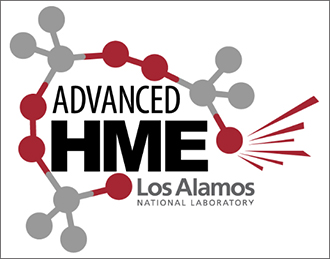
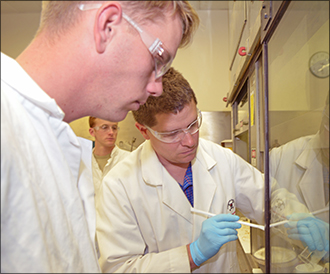
Photo. Bryce Tappan teaches the primaries synthesis laboratory to students behind a blast shield.
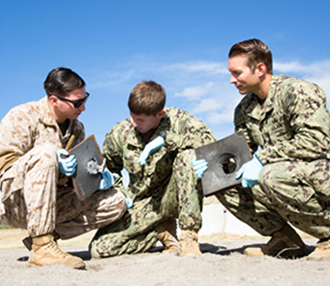
Photo. Students compare witness plates following performance testing of materials prepared in the class.
On October 19, a diverse team of scientists, technologists, technicians, and professional staff completed the 45th offering of the LANL Advanced Homemade Explosives (HME) Course, which has been awarded Program of Record funding through the Navy Center for EOD (Explosive Ordnance Disposal) and Diving. The primary objective of the class is to provide EOD technicians with the advanced knowledge and critical thinking necessary to identify and handle HMEs safely. Five days of hands-on training at the Lab emphasize safety and awareness through HME synthesis and formulation, HME performance, and HME detection. The team has trained more than 800 students and is scheduled to complete 9 classes in both 2018 and 2019, training as many as 24 EOD technicians per class.
The Lab developed the hands-on training course in 2012 after the Department of Defense expressed a need for safe training for EOD technicians. The Laboratory team was nearing completion of a series of three-day courses in HME situational awareness for the Pentagon’s Joint Improvised Explosive Device Defeat Organization (JIEDDO). The JIEDDO provided the initial funding for the development and first few years of training for what is now the five-day hands-on LANL Advanced HME Explosives Course.
Since its inception during the Manhattan Project, the Laboratory has developed cradle-to-grave expertise in explosives development, characterization, and testing. The Advanced HME Class Team leverages 75 years of expertise in comprehensive explosives development. Co-principal investigators Virginia Manner (HE Science and Technology, M-7), Margo Greenfield (Shock and Detonation Physics, M-9), and Jackie Veauthier (Inorganic, Isotope and Actinide Chemistry, C-IIAC) have led the HME course. Current team members include J. AlderseBaes and J. Whitton (Intelligence and Systems Analysis, A-2), J. Veauthier (C-IIAC), D. Oschwald (Physical Chemistry and Applied Spectroscopy, C-PCS), A. Cartelli, C. Campbell, M. Campbell, and A. Novak (Explosives Applications and Special Projects, M-6); S. Anthony, P. Bowden, G. Brown, D. Chavez, A. Duque, L. Fleming, E. Hartline, P. Leonard, V. Manner, D. McDonald, A. Schmalzer, C. Snyder, B. Tappan, and K. Windler (M-7); K. Brown, M. Greenfield, S. McGrane, D. Moore, and K. Paul (M-9); M. Quartieri (Explosive Science and Shock Physics, M-DO); W. Boncher (W88 Alteration and Refresh Program, Q-17); and C. Johansen (Emergency Response, EO-ER). The National Security and Defense Program Office manages the course.
The course has received several awards and recognition through the Los Alamos Award Program, the NNSA Defense Programs Awards of Excellence, and in two LANL press release videos (https://www.lanl.gov/projects/explosives-detection/capabilities/training.php). The DoD Center for Explosives Ordnance Disposal and Diving funds the class. The work supports the Lab’s Global Security mission area and the Science of Signatures and Materials for the Future science pillars. Technical contacts: Virginia Manner and Jackie Veauthier
Claire Sanders and Scott Cram lecture at the 41st Annual Course in Cytometry
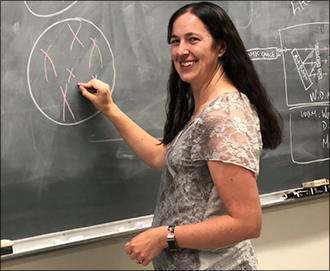
Photo. Claire Sanders teaching at the 41st annual Flow Course.
Los Alamos developed the flow cytometry cell separation technique in the 1960s. The Lab has continued to advance technology development as well as promote education and training – primarily through its role in the NIH-funded National Flow Cytometry Sorting and Research Resource that was housed at Los Alamos from 1983-2014. One of the main elements of the training program has been the Annual Course in Cytometry, which is now in its 41st year. Clair Sanders (B-11) and Lab retiree Scott Cram taught sections of this year’s course in Bowdoin, ME.
Sanders has taught laboratory sessions at eight courses with Cram, who has received the Los Alamos Medal for his pioneering use of flow cytometry to isolate chromosomes for the Human Genome Project. In their hands-on lab Sanders and Cram walked the students through the isolation, staining, and flow cytometric analysis of mammalian chromosomes from hamster cells in culture. Students learned the specifics of this procedure, instrument optimization, and small particles analysis.
The work supports the Lab’s Global Security mission area and the Science of Signatures science pillar. Technical contact: Claire Sanders
Ricardo Lebensohn teaches Texas A&M’s Summer School on Computational Materials Science
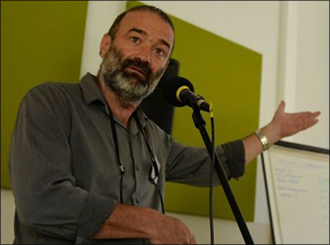
Photo. Ricardo Lebensohn lecturing.
The Texas A&M University Computational Materials Science Across Scales program provides knowledge exchange for academics and trains graduate students. The annual summer school offers a thorough overview of some of the most important computational tools currently in use to investigate materials phenomena at multiple scales, ranging from the continuum to the electronic structure level. The course also presents the latest advances in materials informatics for materials discovery and design. The two-week long summer school took place at Texas A&M in College Station, TX.
Ricardo Lebensohn (Fluid Dynamics and Solid Mechanics, T-3) taught the school’s “Polycrystal Plasticity” module. He focused on the theories and corresponding numerical codes developed at the Lab for physically-based modelling of the mechanical behavior of polycrystalline aggregates. Polycrystals are a class of materials whose complexity requires the use of models at different spatial and temporal scales for a quantitatively-accurate and microstructure-sensitive prediction of their mechanical properties. Lebensohn, along with a group of distinguished scientists and scholars, is also member the summer school’s advisory board.
Lebensohn has worked in the area of structure/property relationship of polycrystalline materials for more than 25 years and is an expert in crystal plasticity modelling. His contributions include the viscoplastic self-consistent (VPSC) code, a homogenization-based polycrystal plasticity simulation tool for the prediction of mechanical response and microstructure evolution of polycrystalline aggregates and Fast Fourier Transform (FFT)-based codes, for the prediction of micromechanical fields in experimental mechanics. His work supports the Lab’s Energy Security Mission area and the Materials for the Future science pillar. Technical contact: Ricardo Lebensohn
Materials Science and Technology
Fusion-relevant simulations show new helium bubble growth mode in tungsten
The design of materials that withstand the extreme radiative environment in fusion reactors presents a significant technical outstanding challenge. Due to its excellent material properties, tungsten (W) is a leading material choice for plasma-facing material in these reactors. As a reactor component, tungsten will be implanted with a high flux of low energy helium ions. However, helium implantation causes morphological changes that might disrupt the material’s performance and lead to contamination of the plasma. A team from Los Alamos and Oak Ridge National Laboratory (ORNL) used simulations of fusion-relevant conditions to reveal a new helium bubble growth mode in tungsten. The journal Materials Research Letters published their findings.
The study relied on ORNL’s Titan high-performance computing clusters, which provided about 5,000 CPUs for a total of about two million CPU hours. The researchers created models of accelerated molecular dynamics of helium bubble nucleation and growth at tungsten Σ5(310)[001] grain boundaries. In the simulation, helium interstitial atoms (or helium atoms that exist in a gap between crystal lattice sites) migrated slowly at grain boundaries (about 1–3 ns per hop) and then nucleated bubbles by punching of interstitials. The figure shows the simulations for helium implantation at a rate of 108 helium atoms per second (left panel) and a rate of 107 helium atoms per second (right panel). Thermodynamic interactions with the bubble itself prevented the interstitials from escaping. This caused the interstitial halo to block helium supply to the bubble.
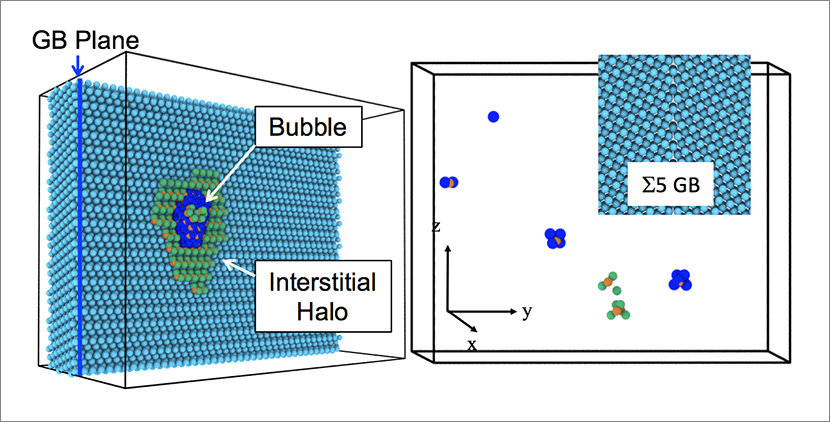
Figure. (Left): Helium bubble growth at a tungsten grain boundary (GB). The halo of tungsten interstitials around the helium bubble constrains helium arrival and thus bubble growth, with a limited maximum size. (Right): A snapshot of bubble nucleation at the grain boundary shows nucleation of helium clusters containing 6, 4, and 2 helium atoms (blue spheres). Green and orange spheres indicate defects, and cyan spheres are the original tungsten atoms.
The team showed that this novel growth mode — which involved a halo forming around the growing bubble — reduced the bubble’s helium supply and therefore arrested bubble growth. The researchers concluded that the kinetics associated with bubble growth at grain boundaries in tungsten is qualitatively different from that in the bulk. Understanding how helium bubbles nucleate and grow is important for predicting the large-scale evolution of the material, which could help commercialize fusion power by developing plasma-facing materials that tolerate the extreme conditions of elevated temperatures and high particle flux in fusion reactors. This research advances the knowledge of helium evolution at grain boundaries in tungsten, an important consideration for understanding tungsten as a plasma-facing component in fusion reactors.
Reference: “New Helium Bubble Growth Mode at a Symmetric Grain-Boundary in Tungsten: Accelerated Molecular Dynamics Study,” Materials Research Letters 6,:9, 522 (2018); DOI: 10.1080/21663831.2018.1494637. Authors: X.-Y. Liu and B. P. Uberuaga (Materials Science in Radiation and Dynamics Extremes, MST-8), D. Perez and A. F. Voter (Physics and Chemistry of Materials, T-1).
The DOE Office of Fusion Energy Sciences, Office of Basic Energy Sciences’ Materials Sciences and Engineering Division, and Office of Advanced Scientific Computing Research through the Scientific Discovery through Advanced Computing (SciDAC-4) program funded the research at Los Alamos. The team performed research at Los Alamos and computing at ORNL. The work supports the Laboratory’s Energy Security science mission area and its Materials for the Future and Information, Science, and Technology science pillars through the development of materials for fusion reactors. Technical contact: Xiang-Yang (Ben) Liu
Physics
Neutron lifetime measured with unprecedented precision
A free neutron decays with a lifetime of about 15 minutes to form a proton, electron, and antineutrino. Knowledge of the mean neutron lifetime (τn) helps scientists predict the atomic makeup of the early universe and search for physics beyond the Standard Model of particle physics. Measuring the exact lifetime of neutrons is surprisingly difficult. The τn measurements vary depending on the method used, and the potential corrections have always been larger than the uncertainties. The journal Science has published findings from researchers at Los Alamos and their collaborators of the first modern τn measurement with corrections that are smaller than the range of uncertainty. The study paves the way for better understanding of how atoms were first created during the Big Bang.
Researchers at the Los Alamos Neutron Science Center (LANSCE) developed the diagnostics – including the asymmetric trap and the detector – and new techniques required to perform this experiment. The team used the 800-MeV proton beam and ultracold neutrons produced at the Ultracold Neutron Facility at LANSCE to develop an improved method for measuring τn. The ultracold neutrons are of such low energies that they travel only a few meters per second. For this “trap” method, researchers levitated ultracold polarized neutrons in a container using magnetic fields and gravity, holding them in place for as long as an hour until a detector was placed in situ. The detector counted neutrons that had not decayed by determining which particles were reabsorbed into matter. There was no detectable neutron loss caused by interactions with the magnetic and gravitational walls of the trap.
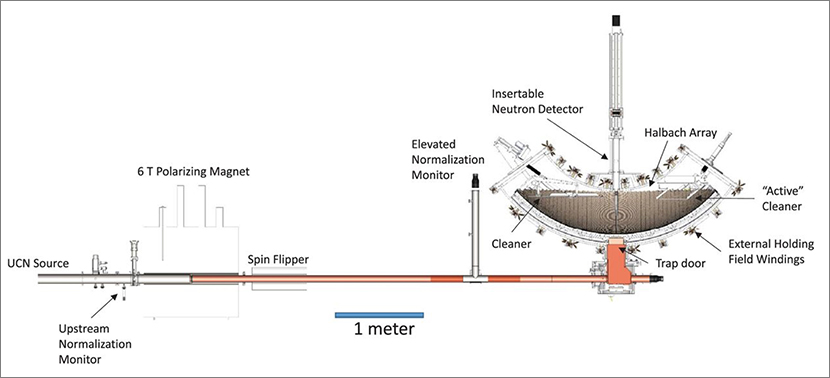
Figure. Layout of the ultracold neutron beam line and trap used for these measurements.
The results of previous measurement techniques have historically disagreed by 9.2 seconds. The new method has narrowed the systematic uncertainty to +0.4/–0.2 seconds. This experiment marks the first time that neutron lifetime measurements did not require corrections larger than the quoted uncertainties. It is also the first time that researchers have used an in situ neutron detector to count neutrons in a trap. Because the study’s measured uncertainties appear to be statistically driven, the team predicts that future studies using this apparatus could reduce the uncertainty of the mean neutron lifetime to well below 0.5 seconds.
Reference: “Measurement of the Neutron Lifetime using a Magneto-gravitational Trap and in situ Detection,” Science 360, 627 (2018); DOI: 10.1126/science.aan8895. Authors: R. W. Pattie Jr., C. Cude-Woods, S. M. Clayton, S. A. Currie, D. E. Fellers, S. W. T. MacDonald, M. Makela, C. L. Morris, J. D. Ortiz, J. Ramsey, A. Saunders, Z. Tang, Z. Wang, W. Wei, H. L. Weaver, and B. A. Zeck (Subatomic Physics (P-25); M. A. Hoffbauer (Chemical Diagnostics and Engineering, C-CDE); S. K. Sjue (Applied Modern Physics, P-21); P. L. Walstrom (Accelerators and Electrodynamics, AOT-AE); T. L. Womack (formerly P-25, now retired); and S. J. Seestrom (formerly at Los Alamos, currently at Sandia National Laboratories). External team members: E. R. Adamek, N. B. Callahan, W. Fox, C.-Y. Liu, and J. Vanderwerp (Indiana University); E. R. Dees, J. W. Wexler, and A. R. Young (Triangle Universities Nuclear Laboratory and North Carolina State University); L. J. Broussard (Oak Ridge National Laboratory); X. Ding (Virginia Polytechnic Institute and State University); E. M. Engel (West Point Military Academy); P. Geltenbort (Institute Laue-Langevin, Grenoble); K. P. Hickerson (California Institute of Technology); A. T. Holley (Tennessee Technological University); A. Komives (DePauw University); D. J. Salvat (University of Washington); and E. L. Sharapov (Joint Institute for Nuclear Research, Russia).
The Los Alamos Laboratory Directed Research and Development (LDRD) program funded the development of the concept and a prototype apparatus at Los Alamos, and the DOE Office of Science Office of Low Energy Nuclear Physics funded the experiments. The work supports the Laboratory’s Nuclear and Particle Futures science pillar by developing capabilities to measure the mean lifetime of the neutron. Technical contact: Andy Saunders
Los Alamos joins CERN’s LHCb team as full member
The Institution Board of the Large Hadron Collider beauty (LHCb) experiment recently recognized Los Alamos as a full member of the collaboration with voting rights to help decide the future of the experiment. The new status comes as Los Alamos scientists lead an effort to design and install new detectors to look for gluon saturation.
This is the first time Los Alamos has been a voting member of a Large Hadron Collider experiment. The LHCb collaboration expects that the high-energy nuclear physics team at Los Alamos will co-lead and boost its incipient nuclear physics program. Seventy-nine organizations comprise the collaboration. LHCb has been operating since 2010.
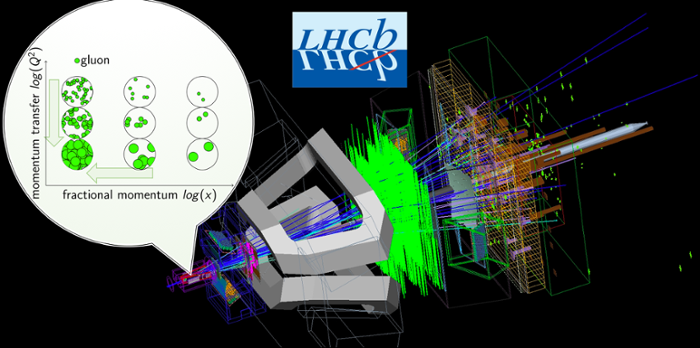
The LHCb detector activity in one proton + lead collision where gluon densities can reach saturation, opening the possibility to observe a strong force condensate for the first time.
The Large Hadron Collider, located near Geneva, Switzerland, is the world’s largest and most powerful accelerator. As one of seven particle physics detector experiments running at the Large Hadron Collider, the LHCb experiment aims to understand why the universe has far more matter than antimatter. This is accomplished by studying the difference between a subatomic particle called the beauty quark (also known as the bottom quark) and its antimatter twin, as well as studying the force that acts upon quarks to bind them, called a gluon, which is a massless subatomic particle.
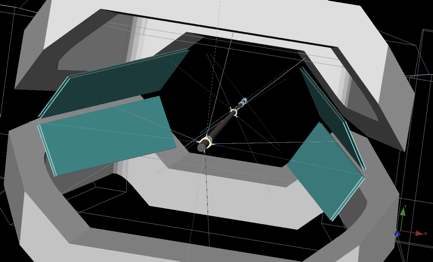
The Magnet Tracker Station (green planes) proposed by LANL inside the LHCb magnet (gray blocks) to detect particles coming from the deep gluon saturation region.
The LANL team found that the LHCb experiment has unique capabilities to examine gluon saturation—the hypothesized process in which gluons start to overlap and fuse. The Standard Model predicts gluon saturation will occur when there is a large number of gluons in limited space; however, it is still unknown whether this occurs naturally. The gluon saturation regime can form a strong force condensate, like other condensates found in cold atoms, but regulated by electromagnetic forces.
Previous attempts at seeing the gluon saturation process have been complicated by unintended nuclear effects. The LHCb can search for gluon saturation through means that are not sensitive to nuclear effects; however, this requires new detectors, which LANL will contribute.
Previously, as the products of the beam collision traveled through the LHCb magnet, soft particles like the ones coming from saturated gluons could not reach the downstream tracking detectors, instead hitting the inner walls of the magnet. The new detectors will mitigate the issues.
With expertise in high-energy nuclear physics as well as detector design and engineering, Los Alamos has been working on the design and prototyping of a particle tracking detector to measure these soft particles. After a thorough review process, LHCb has recommended the installation of a detector prototype and a pathway for full construction in 2025.
The work supports the Laboratory’s Nuclear Deterrence mission area and its Nuclear and Particle Futures science pillar by studying subatomic particles and their contribution to the universe and by developing the expertise and capabilities required for the Lab’s national security mission.
Researchers: Jana Crkovska, Cesar da Silva, Matt Durham, Eliane Epple, Berenice Garcia, Hubert van Hecke, Gerd Kunde (Subatomic Physics, P-25).
Technical contact: Cesar da Silva
Sigma
Neutron diffraction reveals texture changes in low-enriched metallic uranium nuclear fuel
The United States is committed to further strengthening nuclear security and nonproliferation to reduce the threat of terrorists acquiring nuclear material. To meet this important mission, Los Alamos brings its expertise to the task of converting research reactors worldwide to use low-enriched uranium (LEU) fuels, which cannot be used in weapons, rather than highly enriched uranium (HEU) fuels. This work is part of the NNSA’s Office of Material Management and Minimization Reactor Conversion (CONVERT) program.
To aid the development of a widely applicable LEU fuel, Laboratory materials scientists examined the microstructural changes that occur during the fuel fabrication process, a relatively unexplored area of study. Their work revealed texture changes during processing – changes which affect the material’s properties. Understanding these properties is critical for efficiently and economically manufacturing LEU fuel. The journal Quantum Beam Science published their findings.
The team used high-density U-10 wt% Mo (a uranium-molybdenum alloy clad in 6061 aluminum) for their work. Researchers employed a Sigma Division-developed plasma-spray technique as a fast and economical coating method to apply a zirconium (Zr) coating that acts as a diffusion barrier between the fuel and aluminum cladding.
The investigators performed time-of-flight (ToF) neutron diffraction on the high-pressure-preferred orientation (HIPPO) instrument at the Los Alamos Neutron Science Center (LANSCE) to examine the microstructure evolution caused by various plasma temperatures. Neutrons are an excellent probe for bulk texture measurements of uranium and its alloys because they probe the entire sample volume. X-ray or electron-based methods only probe a few micrometers in these materials. The neutron diffraction method collects the bulk information of both substrate (U-10Mo, ~0.3 mm thickness) and thin coating (Zr, ~30 µm thickness) at the same time in a non-destructive way. The neutron diffraction data from HIPPO provides a wide variety of material information including crystallographic textures, phase fractions, lattice parameters, and microstrain.
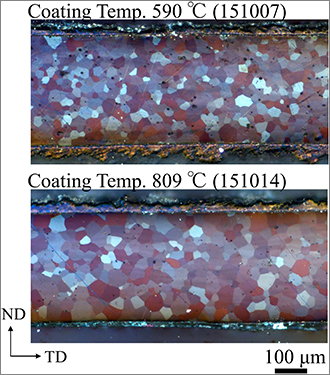
Figure. Optical micrographs of two Zr-coated samples: 151007 and 151014 coated at the lowest and highest temperature, respectively. Both samples showed equiaxed grains, suggesting a recrystallized microstructure, and the grains were coarser near the coating surface than in the center. ND is sample normal and TD is transverse direction.
Quantitative texture analysis revealed that the texture drastically changed at high coating temperatures. The team attributed this result to selective grain growth. This finding agrees with optical microscopy data. Researchers observed larger grains in the samples closer to the coated surface than in the unaffected center volume. For the surface regions exposed to plasma spraying, the average grain size for the lowest temperature agreed with the grain size at the center line. However, the grain size for the sample at the maximum temperature showed an increase of 27.5% relative to the center line grain size. The Zr coating indicated a preferential orientation, which could be related to the initial texture of the uncoated U-10Mo. The authors suggest that this orientation could be explained by epitaxial growth of Zr on the U-10Mo substrate.
Reference: “Texture Evolution in U-10Mo Nuclear Fuel Foils during Plasma Spray Coating with Zr,” Quantum Beam Science 2, 12 (2018); doi.org/10.3390/qubs2020012 Authors: Shigehiro Takajo and Sven C. Vogel (Materials Science in Radiation and Dynamics Extremes, MST-8), Kendall J. Hollis, Dustin R. Cummins and David E. Dombrowski (Fabrication Manufacturing Science, Sigma-1), and Eric L. Tegtmeier (Finishing Manufacturing Science, Sigma-2).
NNSA’s Office of Material Management and Minimization Reactor Conversion Program (Lab Program Manager Dave Dombrowski) funded the work, which supports the Laboratory’s Global and Energy Security mission areas and the Materials for the Future science pillar through the development of methods to produce LEU for reactors. The plasma spray technique leverages the manufacturing science expertise and capabilities of the Laboratory’s Sigma Complex, which supports a large, multidisciplinary materials technology base. The ToF diffraction studies employed capabilities at LANSCE, which uses intense pulsed protons to produce the wide energy spectrum of spallation neutrons needed to interrogate materials. Technical contact: Sven Vogel
Theoretical
A new approach to analyze cell signaling models demonstrated
Models in systems biology seek to describe how the concentrations of key signaling proteins within a cell change in response to a stimulus. Such models are important in understanding biological processes at the single-cell level, as well as predicting cellular responses to therapeutic treatment. To make accurate predictions, models require an acceptable choice of parameters – numerical quantities such as the concentration of proteins and rates of biochemical reactions. In a publication in Nature Communications, Eshan Mitra and Bill Hlavacek (Theoretical Biology and Biophysics, T-6) and collaborators from Northern Arizona University demonstrated an approach that improves cell signaling models by allowing new kinds of experimental data to inform the model parameters.
In a conventional approach, model parameters are fit to quantitative experimental data, such as a dose-response curve for a particular drug. The study demonstrated that it is also possible to include non-numerical, qualitative data in model fitting. The team showed that with a sufficiently large number of qualitative measurements, it is possible to improve quantitative confidence in model parameters. This finding is important in the field of cell biology, where quantitative experiments are often technically challenging to perform, and a large proportion of the available data in the literature is qualitative.
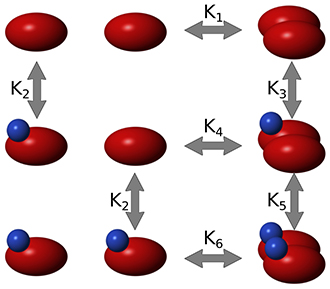
Figure. A simple model of dimerization and inhibition of a protein. Red ovals represent the protein Raf, and blue spheres represent an inhibitor of Raf. This type of model can benefit from qualitative experimental data by applying the methodology of the study.
The team demonstrated the new approach by fitting a model of the cell cycle in yeast. Yeast is used as a model organism to help understand the cell cycle in human cells, which is relevant to cancer. The experimental literature on yeast contains both quantitative data (RNA levels at different time points) and qualitative data (mutant yeast strains with known behaviors). The team implemented an optimization algorithm that found model parameters that were consistent with both types of data. The findings revealed that the combination of both data sets yielded a higher confidence in parameter values than either of the individual data sets.
The results create exciting prospects for future collaborations between experimental and theoretical biologists. By allowing theorists to utilize experimental data that are more readily generated, the new approach is a step toward more accurate, experimentally validated systems biology models.
Reference: “Using Both Qualitative and Quantitative Data in Parameter Identification for Systems Biology Models,” Nature Communications 9, 3901 (2018) DOI: 10.1038/s41467-018-06439-z. Authors: Eshan D. Mitra and William S. Hlavacek (Theoretical Biology and Biophysics, T-6), Raquel Dias Richard G. Posner (Northern Arizona University).
The National Institute of General Medical Sciences of the National Institutes of Health (NIH) funded Bill Hlavacek’s research, and the Laboratory Directed Research and Development (LDRD) program sponsored Eshan Mitra’s work. The research supports the Lab’s Global Security mission area and the Information, Science and Technology science pillar for applications in bio-security and public health. Technical contacts: Eshan Mitra and Bill Hlavacek












